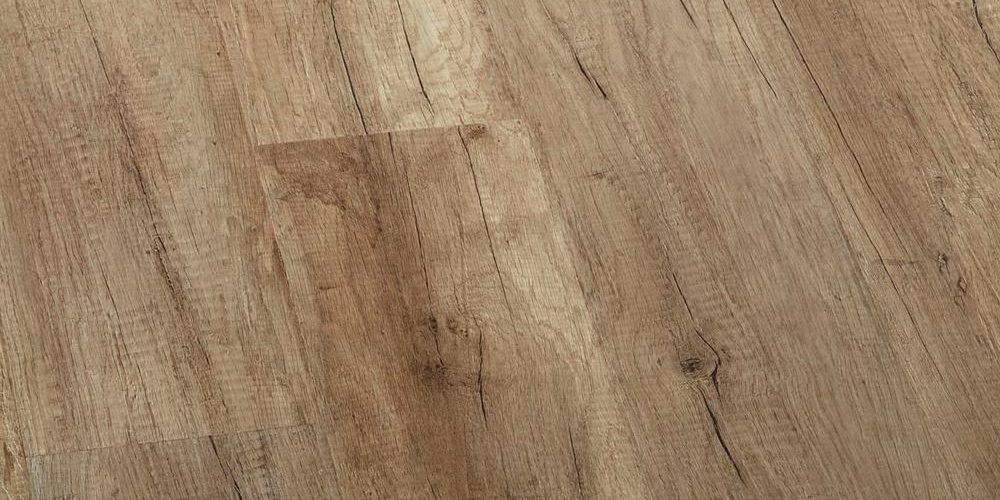Laminate flooring is one of several possibilities when choosing laminate wood flooring products. It is synthetic and multi-layered, with the layers being melded together in a lamination process, either direct pressure or high pressure laminate. The main difference is that laminate made with the high pressure laminate process (HPL) is harder, less likely to gouge, and also more expensive. Direct pressure laminate (DPL) is less expensive and more realistic-looking, because it’s easier to emboss.
Laminated flooring has four layers: the wear layer, the image design layer (or photographic layer), the inner core layer, and the backing layer. The wear layer is an aluminum-oxide containing surface which offers protection from fading, wear, and stains. For residential use, the rating buyers need to look for is a 3 for best assurance of adequate protection against wear. The image design layer is a photographic image of wood, stone, marble, or other materials appliquéd under a transparent protective layer. The third layer, the inner core, is what imparts structural integrity and strength to the floor. The core is formed with fiberboard of high-density combined with melamine, a plastic resin, to further augment the integrity and strength of the floor. This resin also improves resistance to moisture. The final layer, below the inner core, is the backing layer. This layer is a resin-soaked paper, which makes a barrier against moisture, preventing the floor from warping. This backing layer may or may not have glue backing for installation; most laminate floors have a glueless system for installation ease.
Laminate floors are relatively simple for homeowners to install themselves with the glueless system. The discount laminate flooring is bundled together as tongue and groove planks, which are easy to join one to another. Once installed, the laminate floor floats, in a sense, above the sub-floor with the aid of an underlayment of film and foam. This underlayment has both sound and moisture-reduction characteristics.
Even though laminate comes built in with many moisture-resistant capabilities, care still needs to be taken to keep the laminate as dry as possible, since moisture left sitting can lead to swelling or warping of the planks. Liquid spills aren’t a problem if quickly mopped up, though. Some brands do come with water-resistant coatings, which is highly advantageous.
Hardwood laminate flooring has several distinct advantages, the first being its durability. Since it’s protected by a stout outer layer and resin covering, laminate is made much more scratch-resistant and durable than vinyl, carpet, or hardwood flooring. Typically, a quality laminate product will carry warranties of 20 years for wear and tear, as well as moisture resistance. Care does need to be taken, however, to not scratch laminate, as it cannot be refinished as can hardwood.
Laminate floors are fairly low maintenance, however, which is a further advantage. They require minimal care and need no waxing. It’s best to use a cleaner recommended by the manufacturer, rather than mopping with water. Also, it’s advisable to use a wand attachment with a vacuum cleaner rather than a broom, as the broom may drag grit across the floor and lead to scratches.
Another excellent benefit of laminate wood floors is that it’s more cost-effective. It’s less expensive to begin with, and when its endurance and durability are factored in, it becomes a highly economical and practical option. The cost runs from $0.99 to $6.00 a square foot, depending on the thickness of the black laminate flooring. The thicker the bamboo laminate flooring, the more it will cost; thickness varies between 6 and 12 millimeters. The higher of a moisture-resistant quality the glueless laminate flooring has, the more it costs, as well. Installation can vary from $1.00 to $5.00 a square foot, including underlayment. High-quality installation systems will also run at a higher price.
Laminate flooring also offers a wider range of styles than can be found with most other flooring types. It can replicate the look of a wood, stone, or marble floor, whatever might be desired by the homeowner. There are limitless possibilities with laminate designs, and many innovative, beautiful patterns exist. This type of flooring offers both beauty and practicality in one fluid blend.
Laminate flooring was created in 1977 by a Swedish company called Pergo, which remains the most well-known manufacturer of this style of slate laminate flooring. However, there are other major brands such as Armstrong, Mohawk, Columbia, Shaw, and Mannington. These brands all offer high-quality products to suit the needs and desires of many different consumers.
Related Posts
- Laminate Flooring
- How To Clean A Laminate Floor?
- How to Repair Laminate Flooring?
- How to Clean Wood Laminate Floors?



